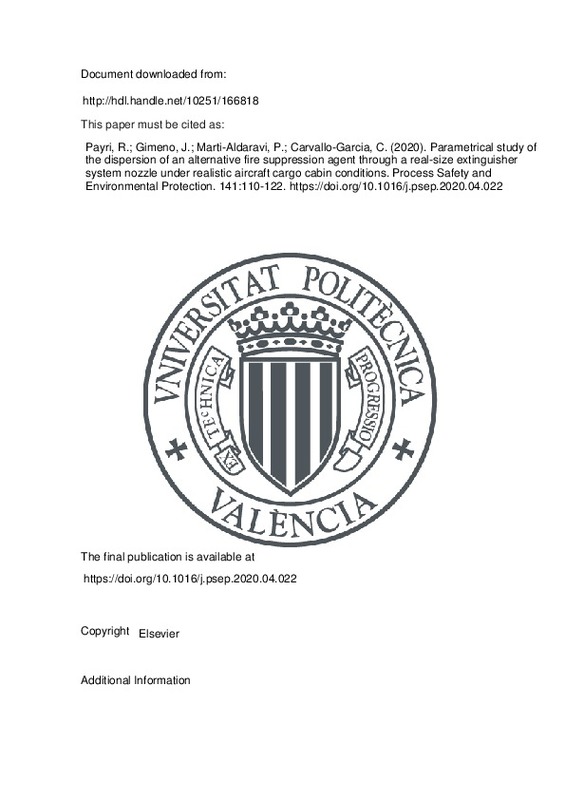Aleiferis, P. G., & van Romunde, Z. R. (2013). An analysis of spray development with iso-octane, n-pentane, gasoline, ethanol and n-butanol from a multi-hole injector under hot fuel conditions. Fuel, 105, 143-168. doi:10.1016/j.fuel.2012.07.044
Amini, G. (2016). Liquid flow in a simplex swirl nozzle. International Journal of Multiphase Flow, 79, 225-235. doi:10.1016/j.ijmultiphaseflow.2015.09.004
Chiu, C.-W., & Li, Y.-H. (2015). Full-scale experimental and numerical analysis of water mist system for sheltered fire sources in wind generator compartment. Process Safety and Environmental Protection, 98, 40-49. doi:10.1016/j.psep.2015.05.011
[+]
Aleiferis, P. G., & van Romunde, Z. R. (2013). An analysis of spray development with iso-octane, n-pentane, gasoline, ethanol and n-butanol from a multi-hole injector under hot fuel conditions. Fuel, 105, 143-168. doi:10.1016/j.fuel.2012.07.044
Amini, G. (2016). Liquid flow in a simplex swirl nozzle. International Journal of Multiphase Flow, 79, 225-235. doi:10.1016/j.ijmultiphaseflow.2015.09.004
Chiu, C.-W., & Li, Y.-H. (2015). Full-scale experimental and numerical analysis of water mist system for sheltered fire sources in wind generator compartment. Process Safety and Environmental Protection, 98, 40-49. doi:10.1016/j.psep.2015.05.011
Gann, R. G. (1998). Fire Technology, 34(4), 363-371. doi:10.1023/a:1015370628661
Genzale, C. L., Reitz, R. D., & Musculus, M. P. B. (2009). Effects of spray targeting on mixture development and emissions formation in late-injection low-temperature heavy-duty diesel combustion. Proceedings of the Combustion Institute, 32(2), 2767-2774. doi:10.1016/j.proci.2008.06.072
Gong, C., Jangi, M., & Bai, X.-S. (2014). Large eddy simulation of n-Dodecane spray combustion in a high pressure combustion vessel. Applied Energy, 136, 373-381. doi:10.1016/j.apenergy.2014.09.030
Grosshandler, W., Presser, C., Lowe, D., & Rinkinen, W. (1995). Assessing Halon Alternatives for Aircraft Engine Nacelle Fire Suppression. Journal of Heat Transfer, 117(2), 489-494. doi:10.1115/1.2822548
Kim, S. C., & Ryou, H. S. (2003). An experimental and numerical study on fire suppression using a water mist in an enclosure. Building and Environment, 38(11), 1309-1316. doi:10.1016/s0360-1323(03)00134-3
Liang, T., Liu, M., Liu, Z., Zhong, W., Xiao, X., & Lo, S. (2015). A study of the probability distribution of pool fire extinguishing times using water mist. Process Safety and Environmental Protection, 93, 240-248. doi:10.1016/j.psep.2014.05.009
McLinden, M. O., Perkins, R. A., Lemmon, E. W., & Fortin, T. J. (2015). Thermodynamic Properties of 1,1,1,2,2,4,5,5,5-Nonafluoro-4-(trifluoromethyl)-3-pentanone: Vapor Pressure, (p, ρ, T) Behavior, and Speed of Sound Measurements, and an Equation of State. Journal of Chemical & Engineering Data, 60(12), 3646-3659. doi:10.1021/acs.jced.5b00623
Modak, A. U., Abbud-Madrid, A., Delplanque, J.-P., & Kee, R. J. (2006). The effect of mono-dispersed water mist on the suppression of laminar premixed hydrogen–, methane–, and propane–air flames. Combustion and Flame, 144(1-2), 103-111. doi:10.1016/j.combustflame.2005.07.003
NDUBIZU, C. C., ANANTH, R., & TATEM, P. A. (2000). The Effects of Droplet Size and Injection Orientation on Water Mist Suppression of Low and High Boiling Point Liquid Pool Fires. Combustion Science and Technology, 157(1), 63-86. doi:10.1080/00102200008947310
Pagliaro, J. L., & Linteris, G. T. (2017). Hydrocarbon flame inhibition by C6F12O (Novec 1230): Unstretched burning velocity measurements and predictions. Fire Safety Journal, 87, 10-17. doi:10.1016/j.firesaf.2016.11.002
Payri, R., García-Oliver, J. M., Bardi, M., & Manin, J. (2012). Fuel temperature influence on diesel sprays in inert and reacting conditions. Applied Thermal Engineering, 35, 185-195. doi:10.1016/j.applthermaleng.2011.10.027
Payri, R., Salvador, F. J., Bracho, G., & Viera, A. (2017). Differences between single and double-pass schlieren imaging on diesel vapor spray characteristics. Applied Thermal Engineering, 125, 220-231. doi:10.1016/j.applthermaleng.2017.06.140
Prasad, K., Li, C., & Kailasanath, K. (1999). Simulation of water mist suppression of small scale methanol liquid pool fires. Fire Safety Journal, 33(3), 185-212. doi:10.1016/s0379-7112(99)00028-4
Reitz, R. D. (1982). Mechanism of atomization of a liquid jet. Physics of Fluids, 25(10), 1730. doi:10.1063/1.863650
Yang, P., Liu, T., & Qin, X. (2010). Experimental and numerical study on water mist suppression system on room fire. Building and Environment, 45(10), 2309-2316. doi:10.1016/j.buildenv.2010.04.017
Yinshui, L., Zhuo, J., Dan, W., & Xiaohui, L. (2014). Experimental research on the water mist fire suppression performance in an enclosed space by changing the characteristics of nozzles. Experimental Thermal and Fluid Science, 52, 174-181. doi:10.1016/j.expthermflusci.2013.09.008
[-]







![[Cerrado]](/themes/UPV/images/candado.png)


